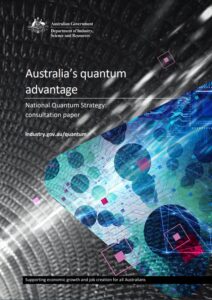FLEET has made the following submission towards the proposed framework of Australia’s National Quantum Strategy. See Consultation Paper.
The ARC Centre of Excellence in Future Low-Energy Electronics Technologies (FLEET; fleet.org.au) is a collaboration between Monash University, Australian National University, University of New South Wales, University of Queensland, RMIT, Swinburne University of Technology, and University of Wollongong, comprising around 200 leading researchers in the fields of quantum technology, quantum materials, electronics, semiconductors, materials science, and electronic devices.
FLEET was formed to address a fundamental challenge: The growth of Information and computing technologies (ICT) is expected to become strongly limited by global energy production in 1-2 decades. FLEET is exploiting new quantum phenomena to build new devices and technologies capable of vastly lowering the energy used in computation, ensuring a sustainable future for ICT.
FLEET’s research is underpinned by novel quantum phenomena in materials:
- Topological materials, in which the topological nature of quantum energy bands give rise to new conducting properties in materials
- Exciton-polaritons, quantum-entangled half-matter, half-light particles which may exhibit spontaneous quantum coherence and superfluid flow in solids
- Bose-Einstein condensates, quantum-coherent superfluids of atomic gases
- Ultrafast quantum control of materials properties using light pulses
FLEET strongly supports the adoption of a National Quantum Strategy to guide research, training, and commercialization of quantum technologies in Australia.
FLEET welcomes this opportunity to provide specific feedback from the perspective of our mission and our researchers. In particular we draw your attention to some key points which we believe should be considered in framing the objectives, some additional initiatives, and one additional objective.
Quantum Technologies (consultation paper, page 7)
FLEET believes that Quantum Technologies (as described through examples on p.7) should be inclusively defined. Defining the scope of Australia’s Quantum Strategy poses a conundrum: It is clear that quantum technologies are an area of unique and exceptional transformative potential, however any rigid definition of quantum technologies is likely to become outdated as new science is generated, and hence risks stifling innovation.
Hence we recommend the adoption of an inclusive definition of quantum technologies as technologies which
- are novel, and
- rely on quantum phenomena (such as quantum superposition, quantum entanglement, quantum decoherence, quantum topology, emergent quasiparticles, and others) which are beyond the simplest single-particle quantum mechanics.
This definition follows the spirit of definitions given by Gerard Milburn (doi.org/10.1098/rsta.2003.1227) or the UK Defence Science and Technology Laboratory report “UK Quantum Technology Landscape” (2014) in distinguishing technologies of the “first quantum revolution” (or “Quantum 1.0”) such as lasers and solid-state transistors, from technologies of the “second quantum revolution” (or “Quantum 2.0”).
Notably, since Quantum 2.0 was first envisioned, additional novel quantum phenomena have risen to importance and are now recognized as promising ingredients for quantum technologies. These include the concept of topology of quantum mechanical states or manifolds, and emergent quasiparticles, such as Majorana zero modes, as important components for quantum technologies such as fault-tolerant topological quantum computation. This underlines the need for an inclusive definition as necessary to anticipate new developments in quantum science and technology.
Objective 3 – Enhance Australia’s global leadership in quantum research (consultation paper, page 11)
Proposed Initiatives
> 3.1 coordinating the delivery of a comprehensive research funding program – in partnership with government and industry bodies – that addresses long and short-term requirements through the prioritisation of key research areas (supporting the spectrum from fundamental research to industrial development)
> 3.2 identifying and growing capability and infrastructure to support advanced research
FLEET is pleased to see the emphasis on the entire spectrum of research from short- to long-term, and fundamental research through development (initiative 3.1). Australia’s leadership position in quantum technologies is the result of sustained investment in basic research with very long time horizons for commercial development. The highly successful silicon quantum computing effort in Australia, for example, grew from the proposal by Bruce Kane at UNSW of a quantum computer based on phosphorus donors in silicon, and development of the idea was supported continuously for over 20 years by an ARC Special Research Centre and three consecutive Centres of Excellence. Australia should not lose sight of the fact that today’s global leading nations in quantum technologies all invested in basic research for decades to reach their current leadership positions, and the leading countries in the next generation of quantum technologies will be those who invest in basic research today.
FLEET would like to emphasise that quantum technologies rely on advancements in quantum materials research (initiative 3.1). Colour centres in semiconductors (such as NV centres in diamond) enable single photon emitters and quantum sensors. Thin-film superconductors and insulating tunnel junctions enable superconducting qubits. Several schemes for quantum computation and quantum simulation are the subject of active quantum materials programs worldwide. For example, fault-tolerant topological quantum computing requires a topological superconducting platform which has not yet been realised experimentally and is the subject of intense research globally. Novel twisted moiré heterostructures of two-dimensional materials have been proposed as a robust platform for quantum simulations. Basic research in quantum materials is a crucial supporting pillar of a thriving quantum technologies ecosystem, and a necessary component of any quantum manufacturing capability Australia might develop.
FLEET believes major research infrastructure is critical for quantum technologies research and development is a high priority (initiative 3.2). Quantum technologies research relies heavily on infrastructure supported by the National Collaborative Research Infrastructure Strategy (NCRIS) such as the National Computational Infrastructure (NCI), Australian National Fabrication Facility (ANFF), and Australian Nuclear Science and Technology Organisation (ANSTO). Australia’s National Quantum Strategy should ensure that critical infrastructure necessary to quantum technology research and development continues to be supported and appropriately expanded to meet the growing needs of the quantum technologies community.
Objective 3 – Enhance Australia’s global leadership in quantum research
Proposed Initiatives
> 3.5 supporting a diverse and inclusive research community
Objective 4 – Drive skilled workforce growth to scale industry and make Australia the top destination for quantum technology talent
Proposed Initiatives
> 4.6 exploring ways to increase participation of underrepresented groups in the quantum industry, including rural and regional Australians. actively promoting Australia as a destination for quantum talent, opportunity and investment, including through targeted incentives
FLEET strongly believes that fostering a diverse, equitable and inclusive environment for research, training, and commercialization will maximise Australia’s human resources and provide fair opportunities for all Australians to participate in this important endeavour. Given the cross-cutting nature of this initiative (it impacts all 7 objectives in the strategy), we urge that this initiative be elevated to the status of an additional Objective within the strategy framework, with specific initiatives addressing all aspects of the framework, including:
- ensuring equitable access to world-leading quantum infrastructure,
- ensuring equitable access to government-sponsored research & commercialization initiatives,
- providing equitable training opportunities and encouraging a diverse quantum workforce,
- fostering global partnership networks which are inclusive.
FLEET has developed strategies to ensure equity and diversity in STEM research, and strongly supports inclusion of principles to ensure equity and diversity across the breadth of Australia’s National Quantum Strategy, and would be delighted to consult on the implementation of a strategy in order to share our successes and learnings.
Objective 4 – Drive skilled workforce growth to scale industry and make Australia the top destination for quantum technology talent
Proposed Initiatives
> 4.4 conducting modelling to identify future quantum workforce requirements, and the necessary supporting educational infrastructure.
> 4.7 targeting key international talent – in particular overseas Australians – that align with national research and growth priorities
Over the life of the Centre, FLEET expects to provide training in the theory, synthesis, fabrication, and characterisation of quantum materials and devices for approximately 100 Honours, Master’s and PhD students in Victoria, Queensland, New South Wales, and the ACT. Many of these graduates will contribute to Australia’s quantum workforce.
FLEET is concerned that the proposed initiatives identify the workforce growth requirements, but do not address how the training will be supported (initiative 4.4). Much of the training of scientists and engineers in quantum technologies will be performed in academic environments, particularly in federally-funded centres such as FLEET. However, it is important to realise that the training throughput for higher degrees in research is limited not by research grants but rather scholarship places, largely funded by the Research Training Program through the Department of Education. Support for increased training of scientists and engineers in quantum technology must be underpinned by a commensurate increase in Research Training Program funding or other source of support for training, ideally indexed to quantum technologies research or targeted specifically towards training in quantum technologies.
FLEET emphasises that the best and most cost-effective opportunity to attract international talent to Australia is at the tertiary education stage (initiative 4.7). Training of the quantum workforce in Australia should recognise this, and provide the resources to attract the world’s best talent and educate them in quantum technologies in Australia. This provides the best prospects for keeping talent in Australia, and moreover helps to build the best academic research environment for quantum technology, which supports the entire ecosystem.
FLEET believes that one of the most effective actions that can be taken by Government in the short term to improve the growth of Australia’s quantum workforce would be to ensure efficient visa pathways for students and workers to enter Australia for training and employment in the quantum industry.
Yours sincerely,
Michael S. Fuhrer
Director, ARC Centre of Excellence in Future Low Energy Electronics Technologies (fleet.org.au)


